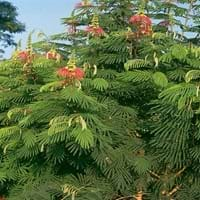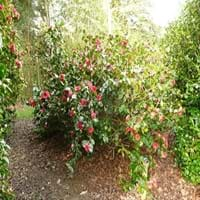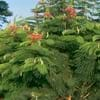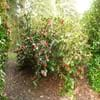Life Span
Perennial
Perennial
Type
Shrub
Broadleaf Evergreen
Origin
South America
China, Japan, Korea
Types
Not available
Not Available
Number of Varieties
Not Available
Habitat
Subtropical climates, Tropical areas, Tropical Climate
Dappled Shade, Shady Edge, Woodland Garden
USDA Hardiness Zone
9-12
7-9
Sunset Zone
H1, H2, 22, 23, 24
4, 5, 6, 7, 8, 9, 12, 14, 15, 16, 17, 18, 19, 20, 21, 22, 23, 24
Habit
Spreading
Oval/Rounded
Flower Color
Red, Magenta
Light Pink
Flower Color Modifier
Not Available
Not Available
Fruit Color
Not Available
Black
Leaf Color in Spring
Green, Light Green, Pink, Copper
Dark Green
Leaf Color in Summer
Green, Light Green
Dark Green
Leaf Color in Fall
Green
Dark Green
Leaf Color in Winter
Green
Dark Green
Leaf Shape
bipinnate
Ovate
Plant Season
Spring, Winter
Spring, Summer, Fall, Winter
Sunlight
Full Sun, Partial Sun
Partial Sun, Partial shade
Growth Rate
Very Fast
Medium
Type of Soil
Loam, Sand
Loam
The pH of Soil
Acidic, Neutral
Acidic, Neutral
Soil Drainage
Well drained
Average
Bloom Time
Early Spring, Spring, Late Spring, Late Fall, Early Winter, Winter, Late Winter
Early Spring, Late Winter
Tolerances
Drought
Not Available
Where to Plant?
Ground
Ground, Pot
How to Plant?
Seedlings
Cuttings, Seedlings
Plant Maintenance
Medium
Medium
Watering Requirements
Average Water Needs
Average Water Needs, Do Not over Water
In Summer
Lots of watering
Drought Tolerant, Average Water
In Spring
Moderate
Moderate
In Winter
Average Water
Average Water
Soil pH
Acidic, Neutral
Acidic, Neutral
Soil Type
Loam, Sand
Loam
Soil Drainage Capacity
Well drained
Average
Sun Exposure
Full Sun, Partial Sun
Partial Sun, Partial shade
Pruning
Remove damaged leaves, Remove dead branches, Remove dead leaves
Remove damaged leaves, Remove dead branches, Remove dead leaves
Fertilizers
All-Purpose Liquid Fertilizer
10-10-10, 8-8-8
Pests and Diseases
Fungal Diseases, Scale insects
Black Mold, Flower Blight, Free of serious pests and diseases, Leaf Gall, Leaf spot
Plant Tolerance
Drought
Not Available
Flower Petal Number
Not Available
Double
Foliage Texture
Fine
Medium
Foliage Sheen
Matte
Glossy
Attracts
Butterflies
Butterflies
Allergy
no allergic reactions
no allergic reactions
Aesthetic Uses
Not Used For Aesthetic Purpose
Bonsai
Beauty Benefits
Not Available
Not Available
Environmental Uses
Air purification
Air purification
Medicinal Uses
Homeopathy
Astringent, Cancer, Haemostatic, Salve, Tonic
Part of Plant Used
Flowers, Wood
Flowers, Leaves, Seeds
Other Uses
Animal Feed, Used as firewood
As a tea substitute, Used as a hair-dressing oil, Used for making green dye
Used As Indoor Plant
No
Yes
Used As Outdoor Plant
Yes
Yes
Garden Design
Feature Plant, Mixed Border, Screening, Wind Break, Tropical
Feature Plant, Foundation, Mixed Border, Topiary, Bonsai, Espalier
Botanical Name
Calliandra calothyrsus
CAMELLIA japonica 'Debutante'
Common Name
powder-puff, powder puff plant, fairy duster
Camellia, Debutante Camellia, Japanese Camellia
In Hindi
Calliandra calothyrsus
Japanese Camellia
In German
Calliandra calothyrsus
Japanische Kamelie
In French
Calliandra calothyrsus
Camellia japonais
In Spanish
Calliandra calothyrsus
Camelia japonesa
In Greek
Calliandra calothyrsus
Ιαπωνικά Camellia
In Portuguese
Calliandra calothyrsus
Camellia japonês
In Polish
Calliandra calothyrsus
Japoński Camellia
In Latin
Calliandra calothyrsus
Camellia Italica
Phylum
Tracheophyta
Magnoliophyta
Class
Magnoliopsida
Magnoliopsida
Genus
Calliandra
Camellia
Clade
Angiosperms, Eudicots, Rosids
Angiosperms, Asterids, Eudicots
Subfamily
Mimosoideae
Theoideae
Number of Species
Not Available
Season and Care of Powder Puff Tree and Japanese Camellia
Season and care of Powder Puff Tree and Japanese Camellia is important to know. While considering everything about Powder Puff Tree and Japanese Camellia Care, growing season is an essential factor. Powder Puff Tree season is Spring and Winter and Japanese Camellia season is Spring and Winter. The type of soil for Powder Puff Tree is Loam, Sand and for Japanese Camellia is Loam while the PH of soil for Powder Puff Tree is Acidic, Neutral and for Japanese Camellia is Acidic, Neutral.
Powder Puff Tree and Japanese Camellia Physical Information
Powder Puff Tree and Japanese Camellia physical information is very important for comparison. Powder Puff Tree height is 180.00 cm and width 240.00 cm whereas Japanese Camellia height is 210.00 cm and width 165.00 cm. The color specification of Powder Puff Tree and Japanese Camellia are as follows:
Powder Puff Tree flower color: Red and Magenta
Powder Puff Tree leaf color: Green, Light Green, Pink and Copper
Japanese Camellia flower color: Light Pink
- Japanese Camellia leaf color: Dark Green
Care of Powder Puff Tree and Japanese Camellia
Care of Powder Puff Tree and Japanese Camellia include pruning, fertilizers, watering etc. Powder Puff Tree pruning is done Remove damaged leaves, Remove dead branches and Remove dead leaves and Japanese Camellia pruning is done Remove damaged leaves, Remove dead branches and Remove dead leaves. In summer Powder Puff Tree needs Lots of watering and in winter, it needs Average Water. Whereas, in summer Japanese Camellia needs Drought Tolerant, Average Water and in winter, it needs Average Water.





